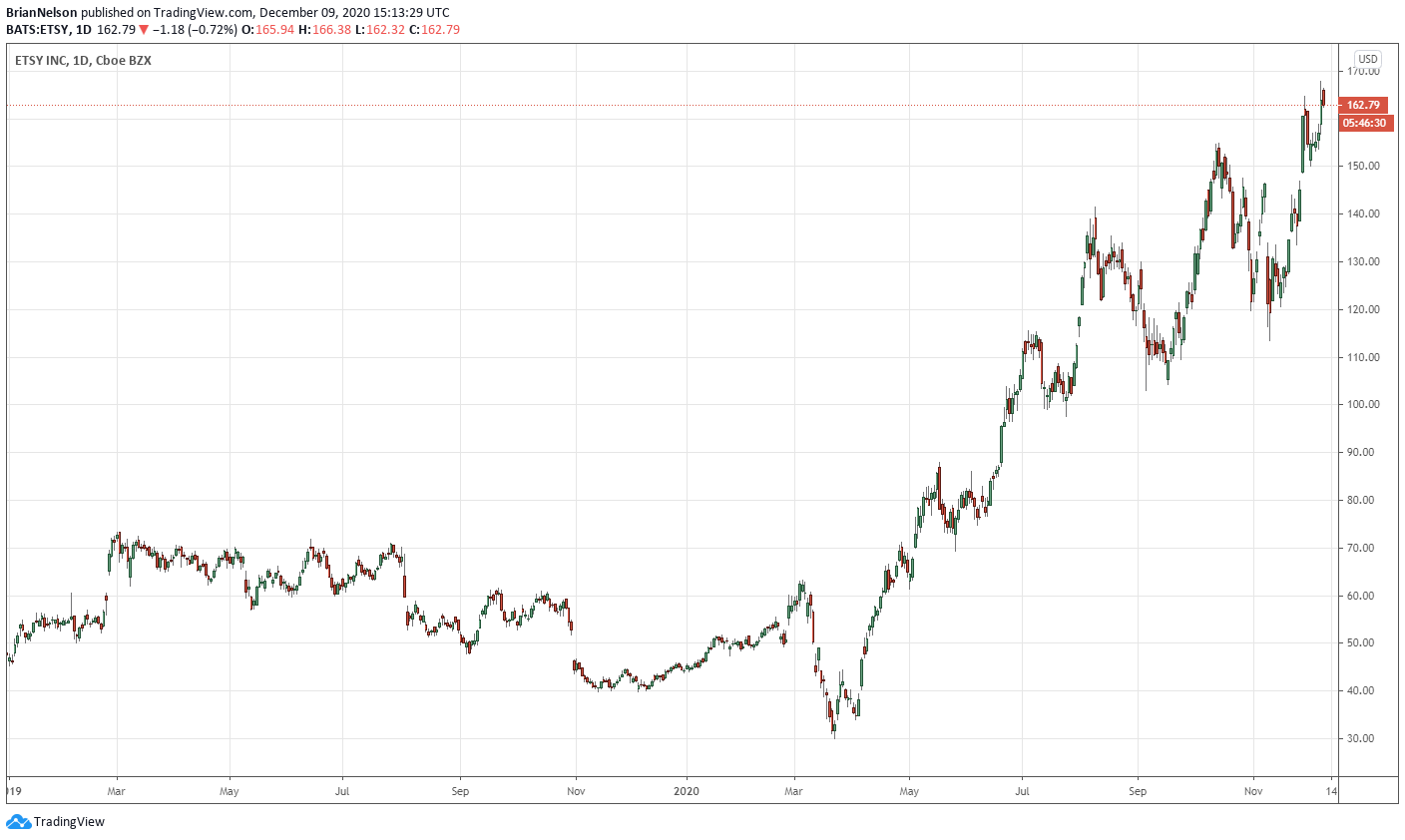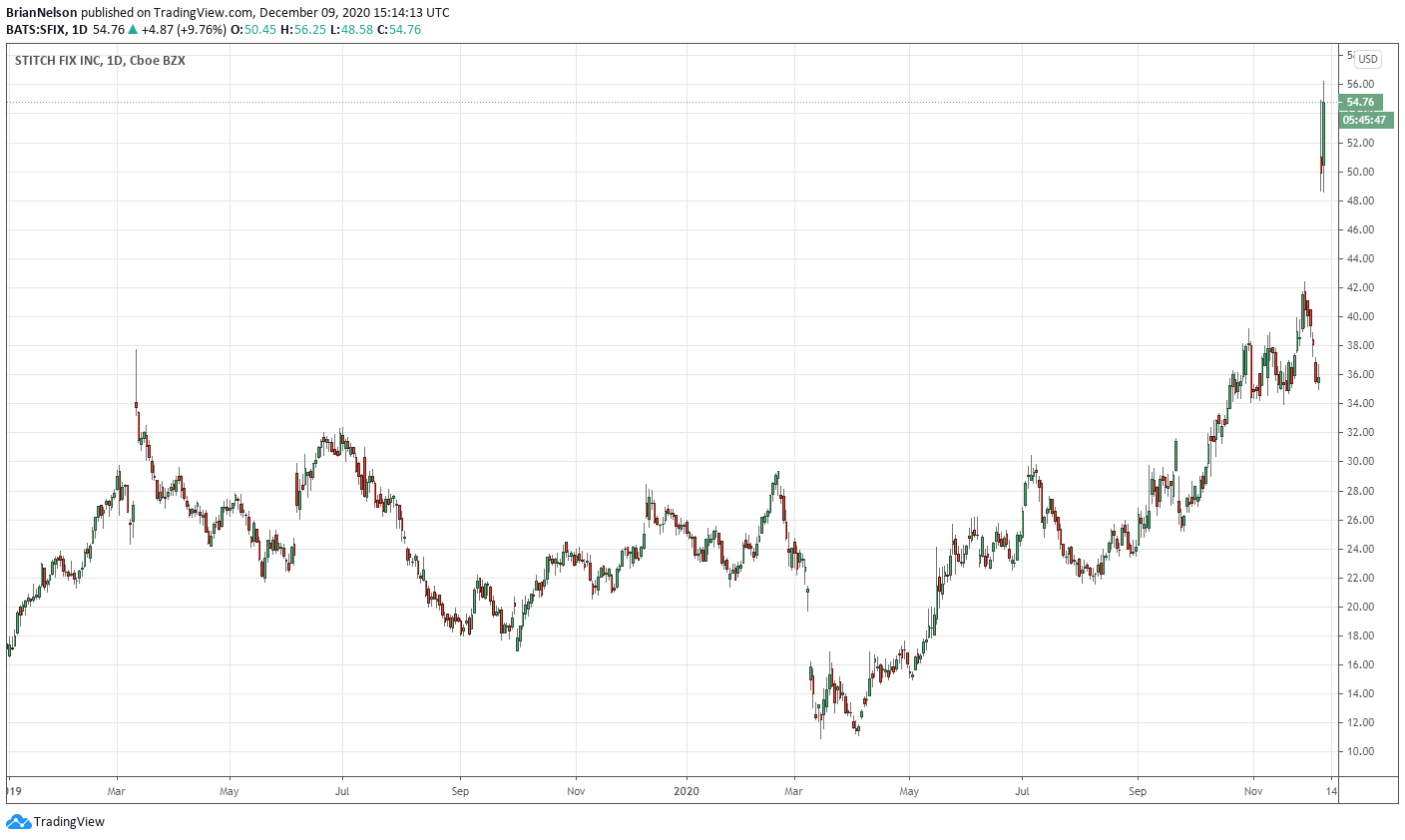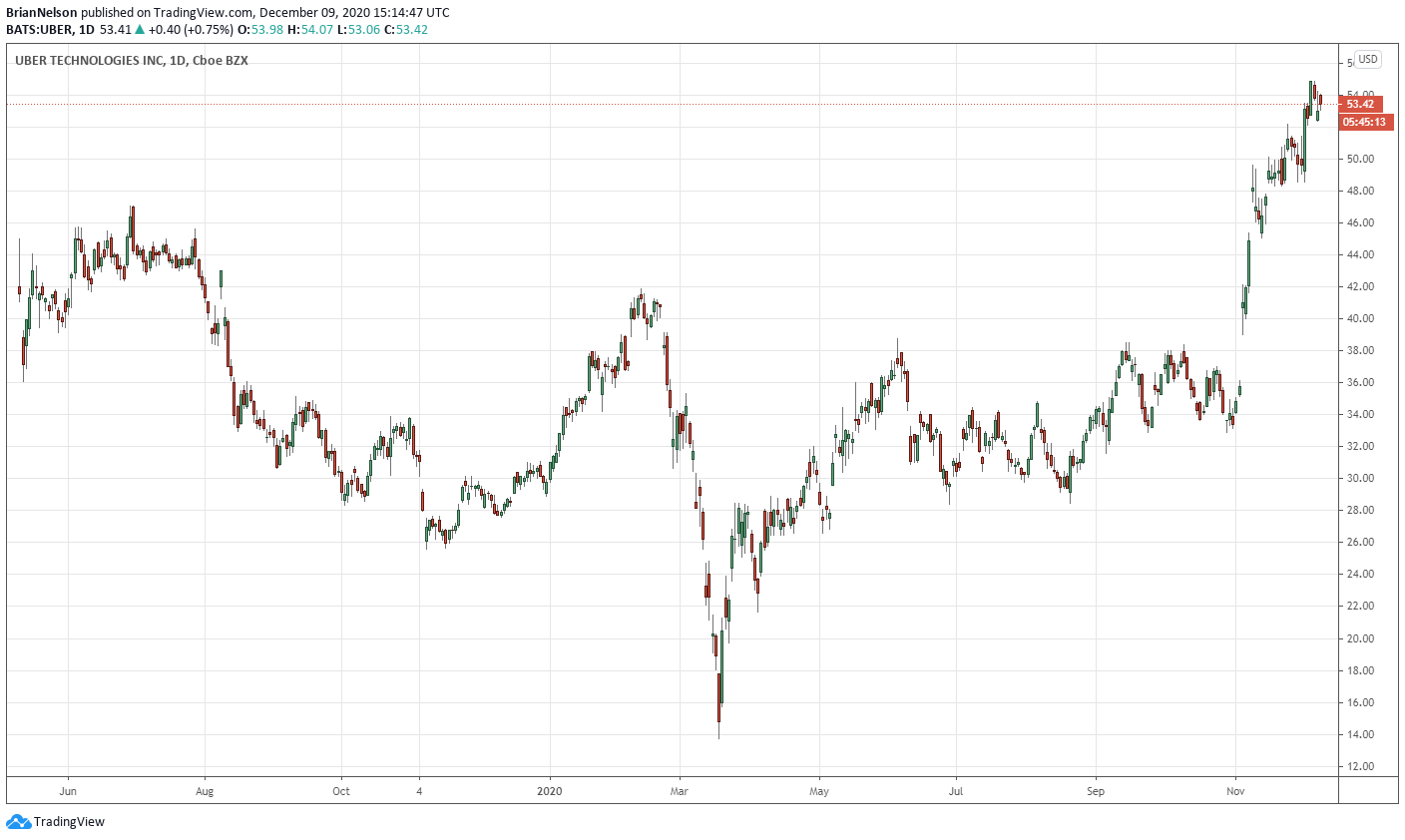3 Speculative Stocks for Your Radar
By Valuentum Analysts
Etsy operates the online marketplace Etsy.com, which connects creative entrepreneurs with consumers looking to find unique crafts and goods. Stitch Fix was founded in 2011 and provides customers with personalized shipments ('Fixes') of apparel, shoes and other items that are hand-picked by the company's stylists. Uber Tech first started in 2010 to make it easy for people to get a ride from point A to point B with the simple touch of a button. All three are breaking out to new highs, and we wanted to put them on the radar of risk-seeking investors.
ETSY, Inc. (ETSY)

Image: ETSY's shares are up more than 270% year-to-date so far in 2020. The company continues to put up sizzling top-line performance, with sales more than doubling during its third quarter, report released October 28. The company's outlook for the fourth quarter calls for revenue growth of 70%-90% and adjusted EBITDA margins in the range of 24%-27%, translating to adjusted EBITDA of ~$117-$131 million. The market has liked the news.
From ETSY's 16-page report:
• Etsy operates the online marketplace Etsy.com, which connects creative entrepreneurs with consumers looking to find unique crafts and goods. In August 2019, the company acquired Reverb, an online marketplace dedicated to selling new and used musical instruments. In 2019, both marketplaces connected nearly 3 million sellers with over 45 million buyers.
• Etsy makes money by collecting fees from sellers that use its marketplace services (e.g. listing goods to sell, completing the transaction). The company also generates services revenue such as advertising sales from sellers looking for prominent placement of their products on the Etsy marketplace.
• Buyers are attracted to Etsy because sellers offer items that generally can't be found anywhere else, while Etsy offers sellers a marketplace with millions of buyers. It is building a nice network effect in the niche arena of creative crafts and items. Top categories include home furnishings, jewelry, craft supplies, and apparel, and 80%+ of sellers identify as women.
• A critical component of Etsy's continued growth will be its ongoing relationship with sellers, which remain a strong component of the foundation of its competitive advantage. The unique items on its marketplace are what attracts buyers, and therefore more sellers, and so on and so forth.
• Etsy is making inroads in a niche area within a business model that eBay (EBAY) largely defined a couple decades ago. Global e-commerce penetration is small enough to allow for plenty of winners, but long-term success is not guaranteed.
ETSY’s 16-page Stock Report (pdf) >>
Stitch Fix (SFIX)

Image: Stitch Fix's shares have soared nearly 110% so far in 2020, and the company posted excellent fiscal first quarter performance, report released December 6. The market loved its outlook calling for 20%-25% growth, which implies an accelerated pace of expansion for the full year (in the fiscal first quarter of 2021, revenue advanced 10%). The market has warmed up significantly to Stitch Fix's shares.
From SFIX's 16-page report:
• Stitch Fix was founded in 2011 and provides customers with personalized shipments ('Fixes') of apparel, shoes and other items that are hand-picked by the company's stylists. It doesn't have physical store locations and makes money by charging styling fees on purchased items and from selling annual Style Passes online. Stitch Fix operates in the US and UK and has roughly 3.8 million active clients.
• Though Stitch Fix has encountered GAAP losses more recently, it has been free-cash-flow positive, averaging $40 million during the past three fiscal years (2018-2020). Cash flow trends look encouraging in fiscal 2021, with the company off to a strong start.
• Stitch Fix's business is gaining momentum. During the first quarter of its fiscal 2021, for example, the company set a number of new records, including one for sequential-quarter client additions. Management believes its outlook is bright and is guiding fiscal 2021 revenue expansion to the range of 20%-25%. We think the company will hit the high end of its target.
• Initially, Stitch Fix focused on women's apparel, but it has since expanded into other segments, including men's and kid's apparel, shoes and accessories. These markets are absolutely huge, and Stitch Fix is tapping into connecting with customers on a personal level to drive demand. Data science remains integral to its business model.
• Providing people with apparel, shoes, and accessories they love in a personalized way is a great way to do business, but competition is fierce across both brick-and-mortar and e-commerce. Nevertheless, we think Stitch Fix has found a growing niche in a massive industry.
Stitch Fix’s 16-page Stock Report >>
Uber Tech (UBER)

Image: Uber just completed its acquisition of Postmates, and its food delivery services have helped it endure the pain of material weakness in its ridesharing business as a result of the outbreak of COVID-19. Better visibility into its cost structure on news that it can keep its drivers as independent contractors (the passing of Proposition 22 in California) and the possibility of a vaccine for COVID-19 coming sooner than expected have breathed new life into Uber's equity. Speculators are bidding up shares.
From Uber's 16-page report:
• Uber Tech first started in 2010 to make it easy for people to get a ride from point A to point B with the simple touch of a button. The company operates applications that connect consumers with independent drivers for ride sharing services. Its platform also connects consumers with restaurants for food delivery services. Uber has incurred billions in losses since its founding.
• The company has five operating segments: Rides, Eats, Freight, Other Bets, Advanced Technologies Group, and Other Technology Programs, the latter two focused on commercializing autonomous vehicle ridesharing solutions. Its Rides segment accounts for the vast majority of current revenue (~75%).
• The ridesharing and meal delivery businesses have low barriers to entry, and competition is intense. In its Rides segment, it competes with Lyft (LYFT), OLA, Didi, and Taxify, while in its Eats segment, key rivals include GrubHub (GRUB), DoorDash (DASH), and even Amazon, to an extent. Its business model and cost profile are also vulnerable to changing labor laws as it classifies its drivers as independent contractors (not employees).
• Operating losses continue to pile up at Uber, and at the end of 2019, the company had an accumulated deficit of $16.4 billion. Uber expects to continue to rack up losses in the near term as it continues to promote its platform. Our fair value estimate assumes Uber is successful in the long run, something that is not guaranteed.
• In December 2020, Uber acquired Postmates, an on-demand food delivery provider in all 50 states with a top share position in Los Angeles. The $2.65 billion all-stock tie-up unites Uber's global Rides and Eats businesses with Postmates' 'delivery-as-a-service' operations
Uber’s 16-page Stock Report >>
-----
Valuentum members have access to our 16-page stock reports, Valuentum Buying Index ratings, Dividend Cushion ratios, fair value estimates and ranges, dividend reports and more. Not a member? Subscribe today. The first 14 days are free.
0 Comments Posted Leave a comment